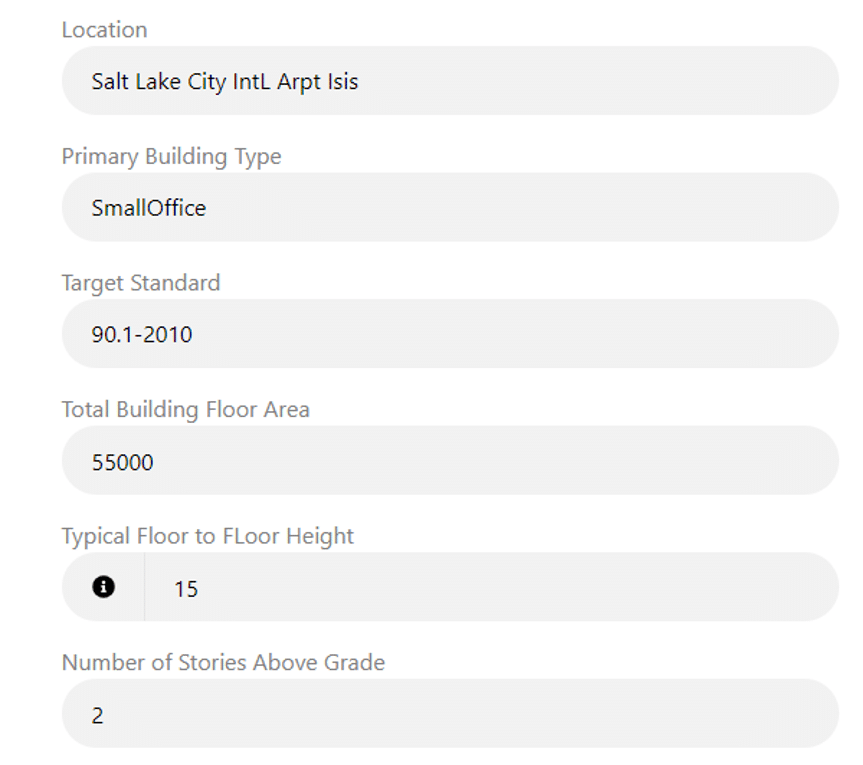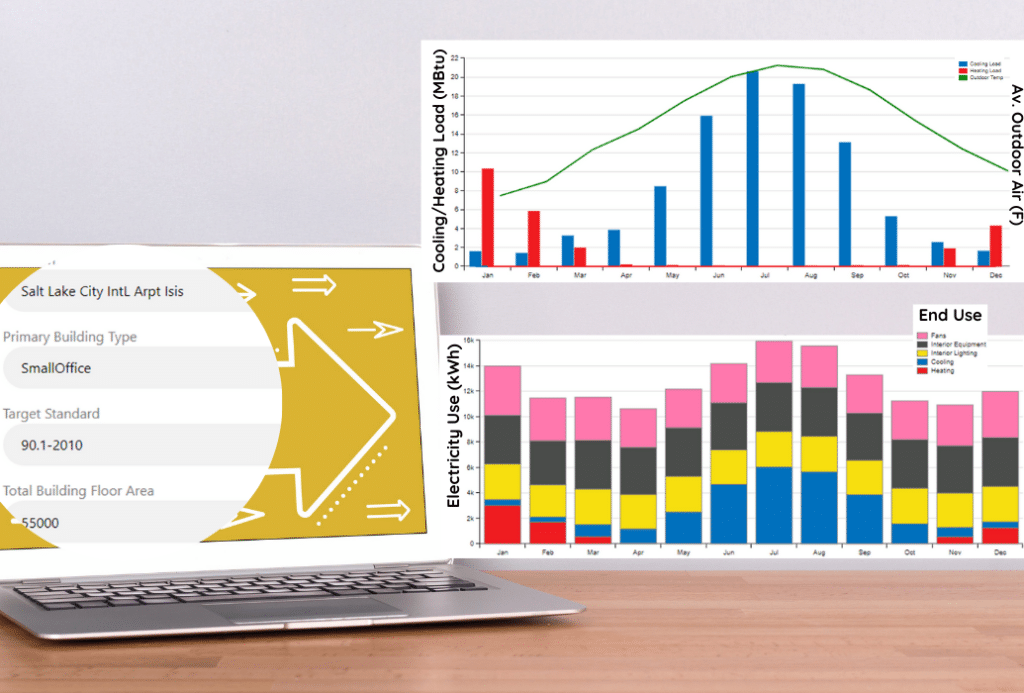Energy modeling is a daunting, but valuable task, and often deemed cost-prohibitive for many building energy savings analysis. For cases where energy modeling can provide valuable insights but traditional methods are not feasible, we developed a web-based modeling tool that provides an online interface which harnesses the power of OpenStudio® and EnergyPlus™. Named Kōritsu, this online tool runs a building simulation using a typical building type, simplified building inputs and automated energy efficiency measure impact simulation to return rough energy savings estimates with a fraction of the time and complexity of traditional modeling tools.
While Kōritsu simplifies the modeling process, its approach is not a panacea for every modeling problem, but has some applications that provide exceptional value. Here’s a brief description of how Kōritsu makes modeling easier, where it’s best applied, and where it’s not.
Complexity of Energy Modeling
Building energy simulation requires a mastery of complex topics like:
- Multiple & simultaneous modes of heat transfer (conduction, convection, and radiation)
- Equipment control sequences and interactions
- Building heat transfer and heat capacity characteristics for physical components like wall materials, insulation, windows, air gaps, and roofs
- Variable equipment performance in response to loads, temperatures, etc.
- Variable loads as a function of building occupancy, time of day, equipment schedules
- Interactions from nearby buildings, shading, solar exposure
- Local weather (including solar insolation, temperature, humidity, wind)
- Interactions from building components (e.g., in winter your lighting reduces heating loads, in summer in increases cooling loads)
These are only some of the interactions considered in energy simulations. The complexity of these factors and the input required to fully characterize the interactions makes it easy to see the importance of matching the modeling effort to the analysis being performed. It’s hard to get these factors right and entire careers have been spent on developing and improving upon how energy modeling is performed.
A simplified approach for easier energy modeling
When a tailored simulation is not in the cards, Kōritsu makes it easy to generate a simulation model that represents the important first-order characteristics that impact a building’s energy use, allowing users to gain many benefits of modeling, without the cost and complexity of a full model. The caveat is that precise inter-building dynamics, such as thermal comfort or daylighting, will not be fully captured in the analysis. For large system-level comparisons however, Kōritsu enables realistic simulation results from a vastly reduced number of inputs. The homework is done for you with built-in assumptions so you can be up and running in no time. Further refinements can then be made if needed.
It starts with vetted ‘typical’ model inputs from various reference building models, including the Department of Energy’s Commercial Reference Buildings and California DEER models., which Kōritsu modifies and combines to match your high-level building characteristics. Leveraging OpenStudio® Measures, specific building use types, operating hours and even overall shape and orientation can be combined and altered to provide detailed results for your building, your system types, and your chosen location. The software builds up the necessary profiles for things like occupancy and lighting, creates zoning appropriate for the space and then runs your model on a web server. Then if you need to make further customization, you can take our work, output the EnergyPlus model, and customize it yourself. This saves a lot of heavy lifting to get a working model for your building.

Sample Kōritsu inputs
Why OpenStudio/EnergyPlus?
EnergyPlus was the best choice for the simulation engine, which the user interface and SDK OpenStudio utilizes. Both are free, and developed under the auspices of the DOE Building Technologies Office (BTO). So, it has the backing of the DOE moving forward, which helps ensure the engine will be around a long time.
EnergyPlus has had an enormous amount of open development and testing to ensure it’s as good as it can be. It’s also extensible, or in other words, you can add to it if you have a system that’s not represented by the core code. This allows it to grow in response to new developments.
Lastly, OpenStudio brings a software development kit and ecosystem that makes EnergyPlus model creation and simulations accessible to modern software tools, such as high-level programming languages (Ruby) and computing services. This provides the winning combination for developing new uses for building energy models.
What applications work with Kōritsu’s simplified modeling approach?
Some of the ways Kōritsu can provide valuable insights with less development time include:
- Analyzing the impact of an energy efficiency measure or group of measures on portfolio or campus of buildings
- Estimating utility incentives for implementing custom measures (like those not included in prescriptive-type programs)
- Schematic design, rough order of magnitude analysis, for measures such as:
- HVAC Optimization
- Load Shifting
- Electrification
- Envelope Optimization
To answer such questions as:
- What if we included better windows?
- What if the orientation were different?
- How does building massing impact my annual use?
- What is the optimal overhang for my windows to reduce HVAC size?
- About how much are the energy and cost savings from (a small sample):
- Improving my motor efficiencies
- A lower lighting density
- Changing occupancy density, or schedules
- … or many more measures
Use Cases for Quick Energy Modeling
A few areas where the power of quick modeling can be used to estimate the impacts of changes in buildings include the following.
Electrification Impacts
The drive for electrification and decarbonization of the grid is becoming a huge policy goal to mitigate climate change, but we must be aware of the grid impacts. With a quick modeling tool like Kōritsu, it’s much easier to test how building design choices impact the grid because the models have hourly load profiles that we can scale and combine to test the impacts on the grid.
To predict the grid impact of electrification, we’ve used Kōritsu to run hundreds of scenarios on portfolios of buildings. By choosing multiple building types, and scaling those to existing demographic information we can make estimates of grid impacts and answer questions like:
- How will electrification change demand load shapes?
- Which types of buildings have the greatest impact on peak demands?
- At what market penetration does existing infrastructure begin to be stressed?
Energy Efficiency Impacts on the Grid
One of other big trends in managing demand-side efficiency is the increased emphasis on when savings occur, not only how much savings occur annually. As the grid is “greened” through further adoption of renewable sources, the “duck curve” gets more pronounced, making time of energy use key to managing grid supply.
Building simulations can be very valuable in helping to determine the load shapes of existing end uses, and the impact of efficiency on those load shapes. Through valuation of energy efficiency as a function of time of savings, we can choose measures to promote at the programmatic level to alleviate the grid energy supply shortage created by renewables.
When is a simplified modeling approach not appropriate?
Kōritsu is not an answer to every problem or design challenge. It uses the best available assumptions to get reliable estimates of impacts quickly and easily, by trading off some accuracy. Kōritsu maximizes reliability by vetting the baseline assumptions, and we only apply it when it is the right tool for the job. At a minimum, Kōritsu aids in the basic model development which can be improved upon if a higher degree of accuracy is needed.
Situations where quick methods are not a substitute for custom simulations include:
- Final design – equipment sizing, load estimation, or similar
- Justifying large investments
- Mechanical zoning
- Code compliance
How would you like to see energy modeling made easier?
We’d welcome your input as we further develop Kōritsu . What would you want to do if you could simulate a building in a fraction of the time? Let us know by reaching out to us through the website or giving us a call.


